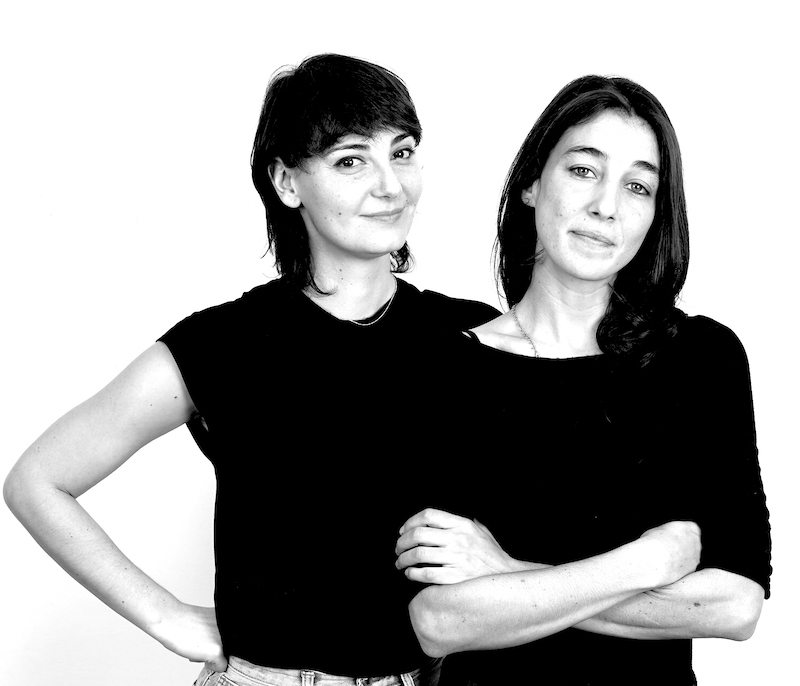About
Margherita Landi
& Agnese Lanza
We develop projects that express the expressive potential of virtual technology, focusing on accessibility, inclusivity, and embodiment that these tools enable.
Our individual research efforts revolve around related and complementary concepts that intertwine and complement each other in these projects realized using Virtual Reality. Agnese approaches movement with a focus on achieving the essence of the gesture, while Margherita concentrates on the processes of emotional projection in the digital world and the transformation of human rituals in relation to technology.
Our work begins with the fundamental concepts of listening, sharing, and connection, transporting them from the physical world to the digital world, thus seeking to eliminate the dichotomy between man and machine and, on the contrary, enhancing the possibility of “enhancing” the human experience through technology.
landilanza@gmail.com
Progetti
EMBRACING PLACES
There is something that touches us all when we let go of our resistance and share a hug. Embracing Places uses immersive technology and body practice to foster connection, solidarity, and appreciation of artistic and cultural heritage.
The project actively involves residents and the unique landscapes of small towns, creating site-specific, community-based artworks that resonate with the emotional significance of each place, establishing an archive of different hugs and a network of towns.
The audience participates in a 360° Virtual Reality experience, where residents of small towns are filmed performing simple gestures like hugging in meaningful local locations. Wearing VR headsets, users are invited to mirror these gestures, transforming their movements into a personal, intimate experience. Spectators without headsets witness the participants’ synchronized movements, creating a live performance that blurs the boundaries between the virtual and physical worlds. The project emphasizes the importance of preserving local culture and fostering empathy in an age of digital interaction. By highlighting the unique ways different communities express connection, Embracing Places aims to address issues of isolation and bring awareness to the cultural richness of underrepresented towns, creating a living archive of shared, universal gestures.
Embodying Absence
‘Embodying Absence’ is the final phase in approaching the theme of absence, following ‘Dealing with Absence’ (absence as distance) and ‘Touching Absence’ (absence as relationship). The last step is a process of research and acceptance of absence as an inner state.
It is often thought that absence is immaterial, forgetting that to perceive it, access to one’s physical and emotional memories is required. In reality, we cannot miss what we do not know or do not remember.
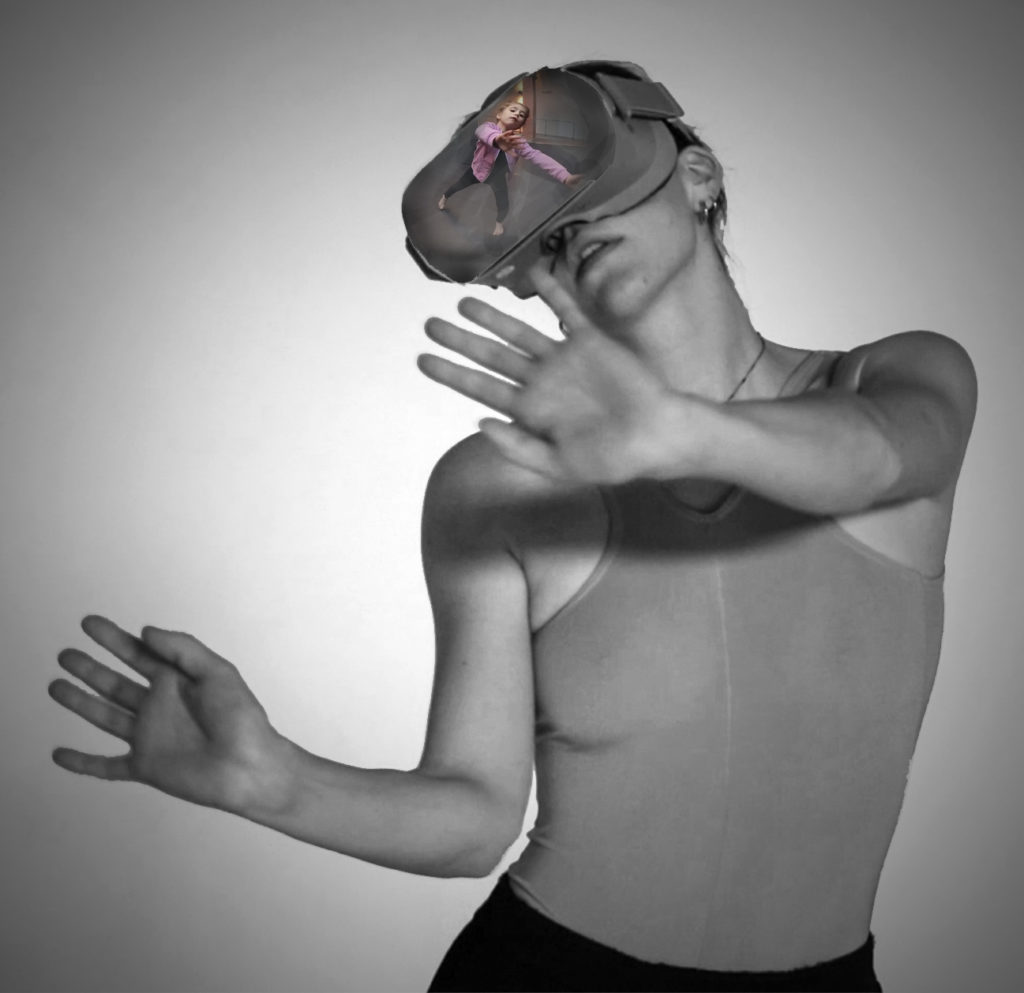
The project aims to work on the real-time learning of a brief movement score through the VR headset and then practice staying in the gaps of memory of what has been learned. The choreographic content consists of scenes that evoke something we all know well: the playfulness of children and their free and imaginative movement when, at around 4-5 years old, they have not yet been contaminated by prejudices or expectations.
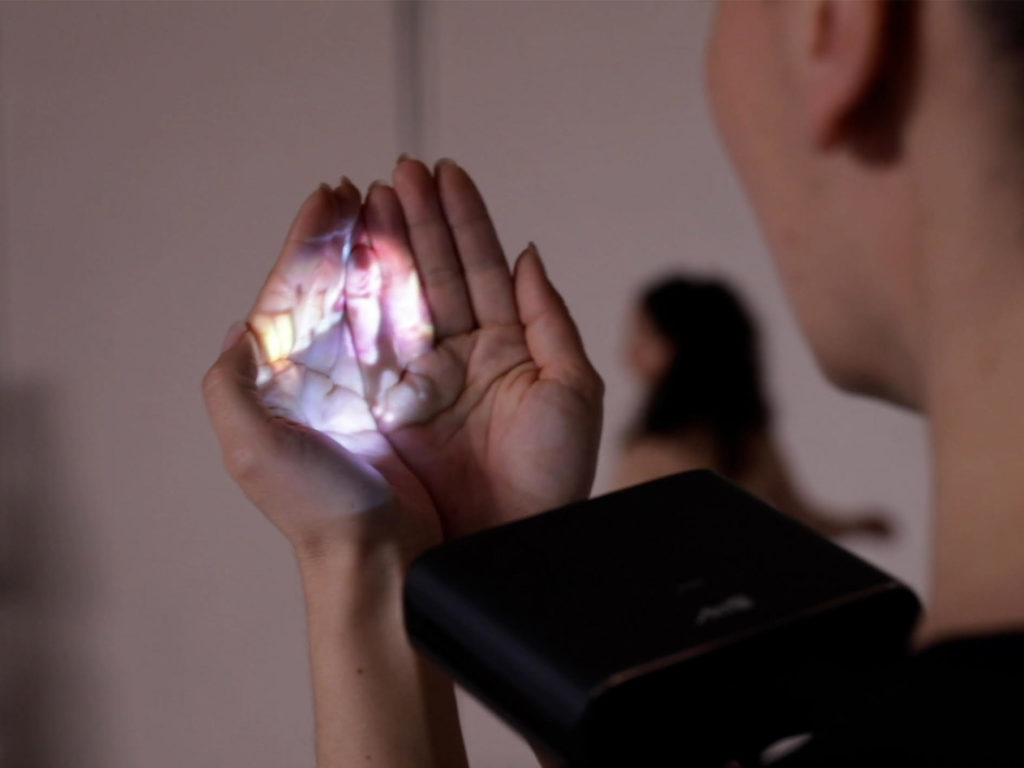
For a dancer, the challenging aspect of accepting the void of memory is the judgment that this moment carries with it. In this profession, one is often required to remember every movement in a sequence. The intention is, in fact, to bring the dancer back to those physical memories preceding the construction of these expectations, to rediscover the beauty of simply being in any dimension, even in the void.
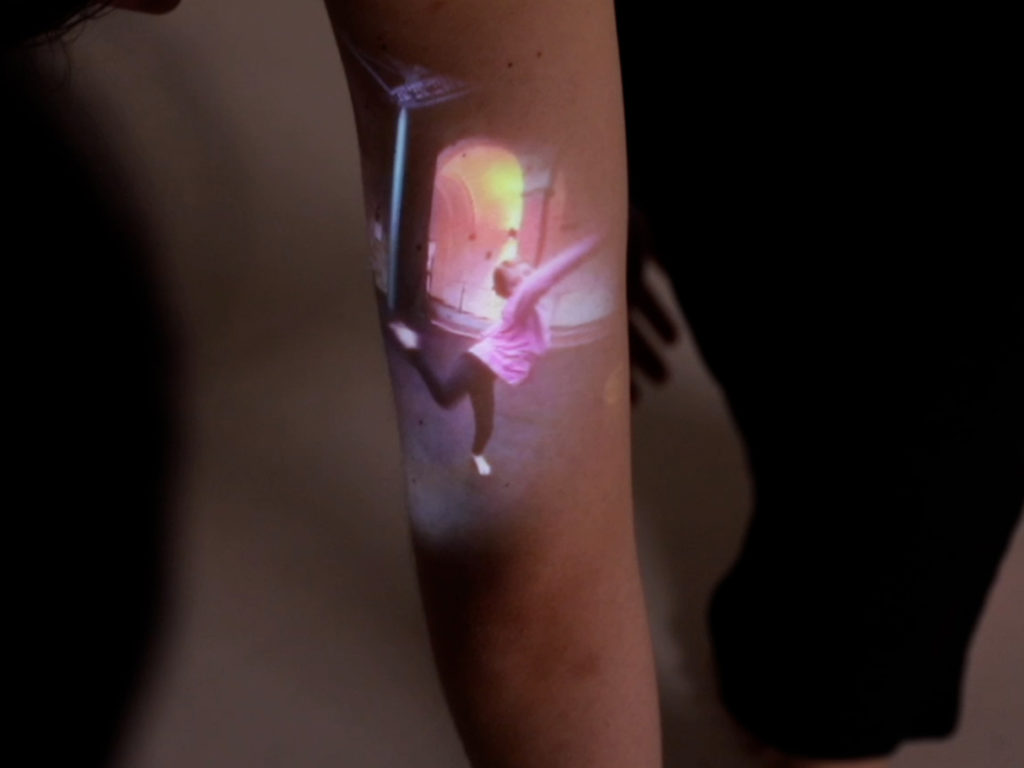
The Virtual Reality (VR) headset here becomes a present/absent object, the primary experiential tool, a mask through which one learns in real-time, teleporting the performer to a place of childhood, filled with play and free movement, from which they can spontaneously borrow gestures and sequences, constructing a unique movement score for each person, all starting from the same video material.
The process consists of an ‘inside,’ invisible to the spectator but perceptible on the dancer’s body, and an ‘outside,’ which is the generated performative aftermath
Touching Absence
“Touching Absence” is the second chapter in the exploration of the theme of absence. Following “Dealing with Absence,” which investigated absence as distance, this chapter delves into absence as a relationship, followed by “Embodying Absence,” the third and final step in the research and acceptance of absence as an inner state.”
The project explores the physical dynamics of the relationship between those who are elsewhere, in VR, and those who are here. The VR headset becomes a tool to transport the body into a state of immersion in another reality and absence in our own, leaving us, the observers, with the question: what kind of relationship can we establish with this body and the experience it is undergoing? What is it feeling? Does it need a connection to the here and now, or perhaps the freedom to fully journey into the elsewhere?”
Dealing with abscence
The project is part of a trilogy of works that explore the theme of absence. In this first step, it delves into absence as distance.Through an Instagram call, we sent VR headsets containing choreographic materials to selected dancers, a kind of choreography delivery.
Through Instagram calls, we implemented a kind of choreographic delivery. The selected dancers received Virtual Reality (VR) headsets by mail containing choreographic materials.
This led to a reflection on Virtual Reality on two levels: the dimension inside the headset, where an intimate experience takes place with the viewing of a 360-degree content visible only to the dancer. And outside the headset, which demonstrates how the VR experience influences the body of the viewer/dancer and becomes a resource that generates movement.
The project’s Instagram profile (@dealing_with_absence) is passed from one dancer to another, and through visual storytelling, they have turned it into a diary that narrates their journey.


Peaceful places
Wearing the headset, the viewer encounters five couples and mimics their gestures, incorporating the hugs and affectionate gestures they see, thus composing a simple, instant choreography.
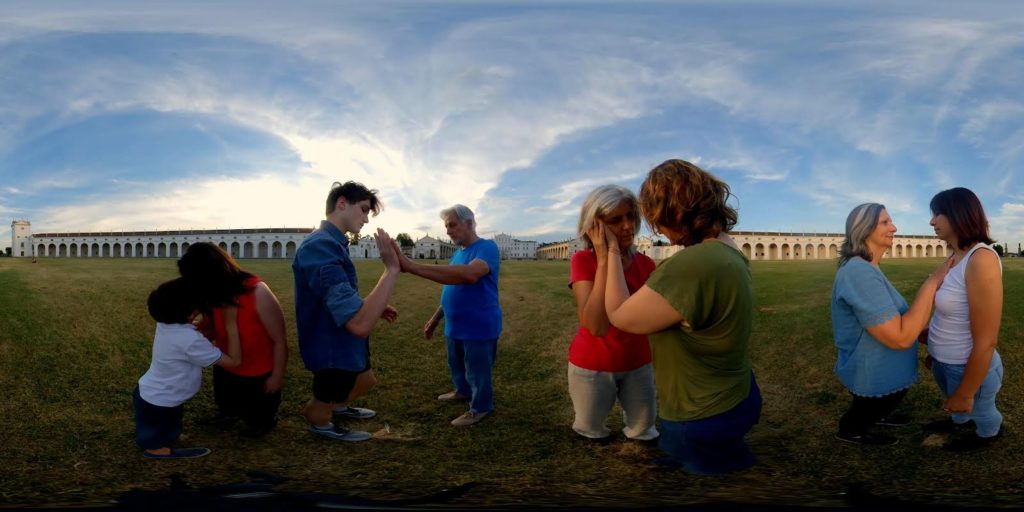
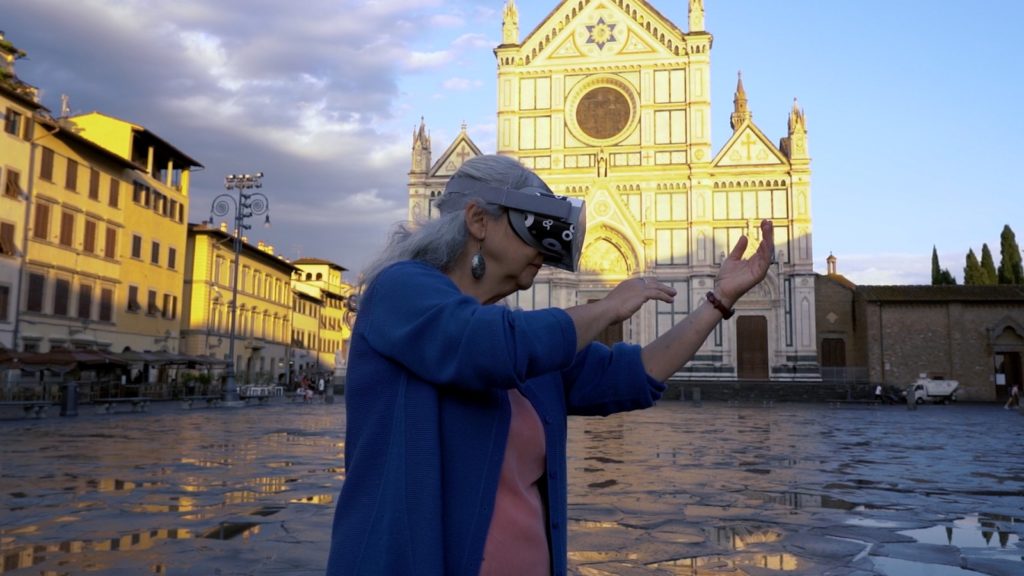
Peaceful Place” is an experimental project that combines physical and emotional experiences through Virtual Reality.
Upon wearing the headset, the viewer encounters four real-life affectionate couples (grandparent and grandchild, mother and son, mother and adult daughter, childhood friends) and mimics their gestures. The user has the opportunity to embody the hugs and affectionate gestures seen in the video, thus starting to move and compose a simple instant choreography made up of affectionate gestures. Virtual reality becomes a tool to “enhance” the bodily experience and, at the same time, a means of conveying a language.
The project is the winner of the 2021 Auggie Award in the Best Art category.
Movements and movie (tu-torial #1)
Two swivel chairs and a selection of scenes from director Jim Jarmusch’s films projected in VR headsets enable the creation of a simple, instant choreography accessible to all, transforming it into a participatory installation.
Through the selection of scenes from films by director Jim Jarmusch, we extracted movements that, when removed from the film’s narrative context, could transform into dance based purely on physicality.
Two swivel chairs enable the content to be experienced in motion, accessible to everyone, and the choreography is designed to be easily interpreted. The work takes the form of a participatory installation.
Tu-torial #1 aims to delve into the process of learning a physical language from the screen, an action we unconsciously perform every day, and the possibility of creating a choreographic score from a video montage.
From Screen to Body (tu-torial #2)
“From Screen to Body” is an evolution of Tutorial #1 in which the two dancers initiate the choreographic act and then pass the headset to two audience volunteers, transforming into a quartet
“From Screen to Body” is an extension of Tutorial #1.
The creation of a choreographic score starting from a video montage has evolved into a performance: Two dancers initiate the choreographic act and then hand over the headset to two audience volunteers, thus forming a quartet.
The two volunteers are brought in to dance together and touch each other; they can see the choreography but not each other.
Workshop
Practicing absence
Workshop for dancers and performers. Listening, tactility, memory, relationship, spatiality can be rediscovered from a new perspective through VR (Virtual Reality).
Presence and absence are not opposing terms but intertwined and often coexisting. Upon close examination, we can admit that ‘absence’ is a difficult concept to grasp. However, there is a materiality often overlooked.
What is absent must already be a part of our corporeality, of our remembered bodily practice, of our habitus, for us to perceive it as lacking. The substance and visceral aspect of absence are provided by the person experiencing it firsthand. The individual undergoing this experience must activate themselves to fill the void.
This workshop aims to investigate this physical and emotional state through practices developed from our research on the body and technology.
Listening, tactility, memory, relationship, spatiality can be rediscovered from a new perspective through VR (Virtual Reality), used by us in an unconventional manner: instead of transporting the body into virtual space, we reposition it in real space through the virtual experience.
Target audience: Dancers and performers, individuals with experience in movement-related practices.
Practicing absence

Embracing WORKSHOP
Inclusive workshop that allows anyone who wishes to participate to have an experience of listening, acceptance, and awareness of what is activated by an embrace.
The objective of the workshop is a journey into physical contact with the other, whether it is a caress, a touch, or a hug. Through breathing and perceptive listening techniques, both of our own body and the other’s body, we will highlight the warmth of the gesture that ties two intimate people.
The work is carried out through a guided improvisation process, based on simple daily movements, which will allow each couple to explore contact from a new perspective and each individual to discover tools for connection with themselves and with the other.
By managing our weight, our strength, and our emotions, we can discover much about the roles and relationships generated by the single encounter of two people embracing.
Couples with different bonds or without any bonds are welcome. No particular skill or prior experience is required.
Embracing WORKSHOP

Biography
Margherita Landi is a choreographer, videomaker, digital artist and anthropologist. Agnese Lanza is a choreographer, dancer, community artist.
In 2019, they presented their first project, “Tu-Torial,” where they explored the relationship between the body and the screen through a reflection on cinema using Virtual Reality.
In 2021, they won the Residenze Digitali grant and developed the project “Dealing with Absence,” creating choreography from a distance through the use of Virtual Reality.
In 2021, they won the Richiedo Asilo Artistico residency program and developed the project “Peaceful Places,” which won the prestigious international XR industry award, the Auggie Awards 2021, in the Best Art category.
Their artistic approach straddles the realms of dance and performing arts, seeking a simple and natural yet highly emotive gesture.
